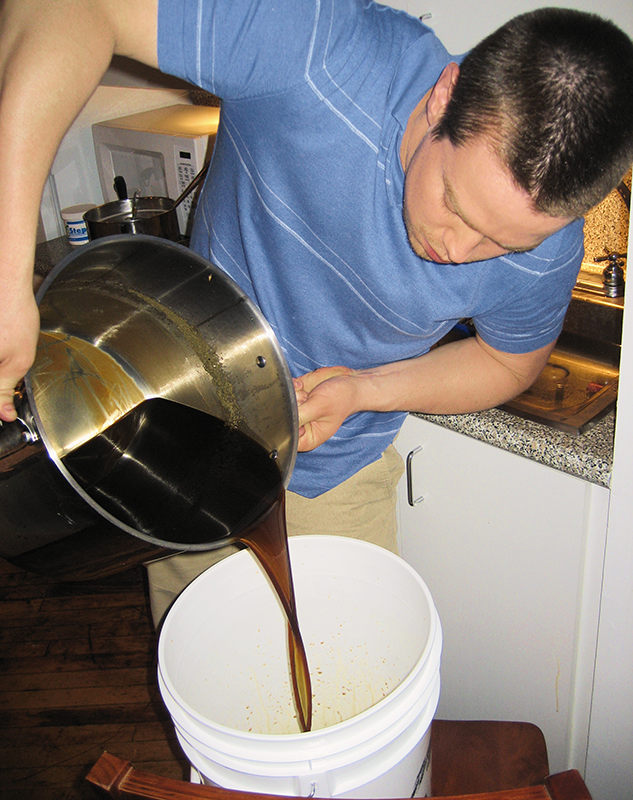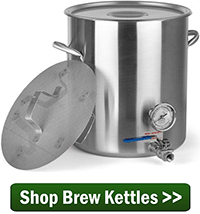 Sooner or later we all reach the limit on our brewing equipment. When it comes to brew kettles, standard procedure is to start with a 5-gallon kettle for partial mash brewing, then eventually upgrade to an 8-, 10-, or 15-gallon kettle in order to advance to all-grain brewing and brew bigger batches.
Sooner or later we all reach the limit on our brewing equipment. When it comes to brew kettles, standard procedure is to start with a 5-gallon kettle for partial mash brewing, then eventually upgrade to an 8-, 10-, or 15-gallon kettle in order to advance to all-grain brewing and brew bigger batches.
But brew kettles can be a big investment. To bridge the gap between your current kettle and the next size up, you can utilize high gravity brewing to brew more beer with less space. In other words, you can brew 15 gallons of beer with your 10-gallon kettle. This will allow you to maximize your brew kettle output before moving to a larger size kettle.
So how does this work?
Think about your typical 5-gallon, partial mash recipe kit. Usually what we do is mix the ingredients into a 3- or 4-gallon boil, then add water (preferably clean, chlorine-free water) to the fermenter to bring up the volume to five gallons. This can also be done with your own homebrew recipes and on a larger scale.
Scaling the Beer Recipe to Maximize Brew Kettle Output
Scaling the grain and/extract side of the recipe is pretty straightforward. As a homebrewer, all you need to do is increase the malts and malt extracts in proportion to the batch size. Say for example the five-gallon recipe you usually make in your 7.5-gallon kettle uses 6.6 lbs. of malt extract. To brew a ten-gallon batch, still use the same amount of water for the boil, but double the malt extract. After diluting in the fermenter, your original gravity should be pretty close to what it is when you brew the five-gallon batch. (Things are a little more complicated when brewing all-grain, but the same principles apply.)
The tricky part with scaling recipes into high gravity versions is controlling hop bitterness. IBUs are directly influenced by hop utilization, which is a factor of boil gravity and boil time. The higher the gravity of the boil, the lower the hop utilization. To compensate for the lower hop utilization, we need to do more than double the hops to arrive at the same IBUs.
 To figure out how much hops to use, work backwards. Say we want the finished beer to have 40 IBUs. We’re planning to brew five gallons of a 1.080 beer, which will be 1.040 after diluting with five gallons of water. That means the IBUs of the brew pre-dilution should be 80. As an example, it may only take 1.5 oz. of hops to reach 40 IBUs when doing a full-volume boil, but it will take 4.3 oz. of the same hops added at the same time to impart the same amount of bitterness in the higher gravity brew. These calculations can be tricky – use an IBU calculator to help you sort it out. In some cases you may want to add half the malt extract at the end of the boil (a late addition) in order to maximize hop utilization.
To figure out how much hops to use, work backwards. Say we want the finished beer to have 40 IBUs. We’re planning to brew five gallons of a 1.080 beer, which will be 1.040 after diluting with five gallons of water. That means the IBUs of the brew pre-dilution should be 80. As an example, it may only take 1.5 oz. of hops to reach 40 IBUs when doing a full-volume boil, but it will take 4.3 oz. of the same hops added at the same time to impart the same amount of bitterness in the higher gravity brew. These calculations can be tricky – use an IBU calculator to help you sort it out. In some cases you may want to add half the malt extract at the end of the boil (a late addition) in order to maximize hop utilization.
Limitations of High Gravity Brewing
To simplify the calculations above, I’ve used a 1:1 ration for dilution (one gallon dilution water for every gallon of wort). In reality, this is about the upper extreme of how much you’d want to dilute a homebrew. Diluting a high gravity boil can certainly be effective, but you want to avoid creating a beer that tastes watered down. Diluting before fermentation will help to avoid this.
Have you every tried brewing high-gravity beers to maximize your brew kettle output? How did it go?
—–
David Ackley is a writer, brewer, and craft beer marketing consultant. He holds a General Certificate in Brewing from the Institute of Brewing and Distilling and is founder of the Local Beer Blog.

I need to do something exactly like this. I am very new to this type of beer making, I used to use Mr.Beer products. I just have a 5 gallon pot, 6.5 primary fermenter, and a 5 gallon glass carboy. I am on Social Security, so buying another bigger pot is out of the question..I recently purchased (by mistake) Patersbier/Belgian Enkel – All-Grain Recipe Kit, and saw something somewhere stating I need a 7 or 8 gallon pot to make this beer? I was considering trying to cut the recipe in half and make half, put it in the primary fermenter, then make the other half. Sounds like with the High Gravity way, I wouldn’t have to do that?
You should be OK using BIAB to do the 60 minute mash with the 5 gallon mash pot 80-90% full with the grain in. Keep in mind that it will foam when the hops are added but the grain will be removed to make enough room. Then top off the carboy to get to 5 gallons. Or instead of topping off in the carboy, you could sparge/rinse the grain bag in a second boil pot. Be careful to keep the mash temp at 152 deg.